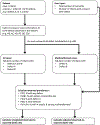Co-occurring defect analysis: A platform for analyzing birth defect co-occurrence in registries
- PMID: 31313535
- PMCID: PMC7814855
- DOI: 10.1002/bdr2.1549
Co-occurring defect analysis: A platform for analyzing birth defect co-occurrence in registries
Abstract
Background: Few studies have systematically evaluated birth defect co-occurrence patterns, perhaps, in part, due to the lack of software designed to implement large-scale, complex analytic methods.
Methods: We created an R-based platform, "co-occurring defect analysis" (CODA), designed to implement analyses of birth defect co-occurrence patterns in birth defect registries. CODA uses an established algorithm for calculating the observed-to-expected ratio of a given birth defect combination, accounting for the known tendency of birth defects to co-occur nonspecifically. To demonstrate CODA's feasibility, we evaluated the computational time needed to assess 2- to 5-way combinations of major birth defects in the Texas Birth Defects Registry (TBDR) (1999-2014). We report on two examples of pairwise patterns, defects co-occurring with trisomy 21 or with non-syndromic spina bifida, to demonstrate proof-of-concept.
Results: We evaluated combinations of 175 major birth defects among 206,784 infants in the TBDR. CODA performed efficiently in the data set, analyzing 1.5 million 5-way combinations in 18 hr. As anticipated, we identified large observed-to-expected ratios for the birth defects that co-occur with trisomy 21 or spina bifida.
Conclusions: CODA is available for application to birth defect data sets and can be used to better understand co-occurrence patterns. Co-occurrence patterns elucidated by using CODA may be helpful for identifying new birth defect associations and may provide etiological insights regarding potentially shared pathogenic mechanisms. CODA may also have wider applications, such as assessing patterns of additional types of co-occurrence patterns in other large data sets (e.g., medical records).
Keywords: birth defects; multiple congenital anomalies; registries; software; syndromes.
© 2019 Wiley Periodicals, Inc.
Conflict of interest statement
CONFLICT OF INTEREST
The authors report no conflicts of interest.
Figures
References
-
- Buchin PJ, Levy JS, & Schullinger JN (1986). Down’s syndrome and the gastrointestinal tract. Journal of Clinical Gastroenterology, 8(2), 111–114. - PubMed
-
- Castilla EE, Lugarinho R, da Graca Dutra M, & Salgado LJ (1998). Associated anomalies in individuals with polydactyly. American Journal of Medical Genetics, 80(5), 459–465. - PubMed
-
- Centers for Disease Control and Prevention (CDC). (2008). Update on overall prevalence of major birth defects--Atlanta, Georgia, 1978–2005. MMWR. Morbidity and Mortality Weekly Report, 57(1), 1–5. - PubMed
Publication types
MeSH terms
Grants and funding
LinkOut - more resources
Full Text Sources
Medical
Research Materials


